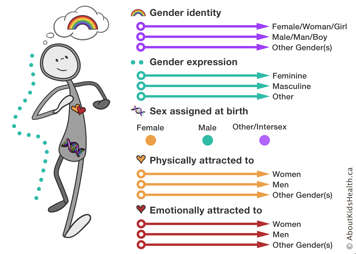We want to hear from you!
AboutKidsHealth is trying to improve the information and education we provide young people (aged 12-18) and families through our website. After reading this article, please take 5 minutes to complete our Adolsecent Health Learning Hub survey.
What is gender?
Traditionally, gender has been defined as being either one of the two sexes: male or female. But gender is actually a much broader concept. There is a lot more to gender than the sex you were assigned at birth, and it does not tell the complete story of who you are.
Identity
It is common for people to confuse sex, gender and even sexual orientation, but they are all different things. Each category exists independently and has its own spectrums. It can be helpful to visualize these concepts through the illustration below.

What is sex?
Sex is determined by biological features including chromosomes (e.g., XX, XY), hormones (e.g., estrogen, progesterone, testosterone), internal reproductive organs (e.g., uterus, vagina, prostate) and external sexual anatomy (e.g., vulva, penis, testicles). People are usually assigned male or female at birth and this marker goes on legal documents such as your birth certificate.
What does it mean to be intersex?
Intersex is a term that describes someone who is born with or develops reproductive or sexual anatomy that doesn’t seem to fit the typical definitions of female or male. One example of an intersex person might be someone who has androgen insensitivity syndrome (AIS). When a person has AIS, their body is resistant to certain sex hormones and can develop differently than what would be expected for the chromosomes that person was born with.
Some people who are intersex will choose to self-identify as intersex and some will adopt a gender identity that best reflects how they feel on the inside.
What is gender identity?
Gender identity is how you feel about your gender on the inside. It is the psychological sense of feeling like a woman, a man, both, in between or something else. Your gender identity is something that you come to understand for yourself. The most common gender identity is cisgender – someone who feels their gender identity matches their assigned sex at birth – but there are many other recognized gender identities. These include, but are not limited to, the following:
- Agender – someone who identifies as having no gender
- Bigender – someone who identifies as having two full genders
- Gender creative – children who identify and express their gender in ways that are different than what society/cultures expect
- Gender fluid – someone who sees their gender as changeable
- Genderqueer – someone who does not conform to society’s expectations for their gender roles or gender expression
- Non-binary –someone whose gender identity is neither male nor female
- Pangender – someone who identifies with multiple and/or all genders
- Trans or transgender – someone whose gender identity differs from their assigned sex at birth
- Two-spirit – a term used by some Indigenous communities to describe the sexual and gender diversity in Indigenous cultures
Most children by the age of three are aware of their own gender, although it is okay to question your gender identity as you grow older. The formation of your identity can be influenced by biological sex, hormones and the environment. Identity can also shift and evolve over time.
What is gender expression?
Gender expression is how you present to the world. It is the way you demonstrate who you are, and it can match traditional gender norms but does not have to. Gender expression can be motivated by your gender identity, sexuality, mood and many other things (e.g., needing to wear a uniform for work or a costume for a performance).
You can demonstrate your gender through your name, pronoun choice, clothing, voice, hairstyle and the ways that you act and interact with others (intentionally or unintentionally). Gender expression is most commonly classified as either masculine, feminine or androgynous, which has elements of both masculinity and femininity. The ways you communicate your gender is flexible and may change depending on the day or setting:
- You may wear an androgynous uniform at work and wear bright feminine colours at home.
- You might keep your hair neat and short during the day and wear fun wigs at night.
- Your may have a deep masculine voice when you are sad and moody, but use a higher-pitched feminine tone when you are feeling giddy and excited.
What are gender norms?
Your gender expression is interpreted by others around you based on the traditional gender norms of your society and culture. Gender norms are the expectations that your society traditionally has for women and men (e.g., men wear pants; women wear dresses). These can include expectations about how each gender should:
- be classified, identified and treated under the law
- speak and be spoken to
- perform their respective gender roles
- dress or wear their hair
- play with toys and engage in sports activities
- form relationships and families
- be educated and which industries they should work within
There are many different norms for gender expression, and they vary by culture, generation, region, and between communities and peer groups. Because gender expression and norms are constantly changing, it is important to remember that there is no one “right” way to demonstrate gender. Your gender expression is your choice.
What is sexual orientation?
Your sexual orientation is who you are attracted to, sexually and/or romantically. Sexual attraction is the desire to have sexual contact with someone, while romantic attraction is the desire for emotional relationships and intimacy. The label of your sexual identity will usually describe the relationship between your gender identity and the gender identities of the people you are attracted to. The most common sexual orientation is straight – someone who is primarily attracted to the opposite gender – but there are many other recognized sexual orientations. These include, but are not limited to, the following:
- Gay – a male who is attracted to males
- Lesbian – a female who is attracted to females
- Bisexual – a male or female who is attracted to both males and females (not always equally or at the same time)
- Pansexual – someone who is attracted to people of any gender
- Asexual – someone who is not sexually attracted to any gender
- Some asexual people experience romantic attraction, and others do not
- Queer – a general term for someone who is not straight
If your sexual orientation is not straight, you may identify as belonging to the “queer community” or the LGBTQ2S+ community. LGBTQ2S+ stands for lesbian, gay, bisexual, transgender, queer/questioning and two-spirit; and the plus indicates that nobody is left out.






